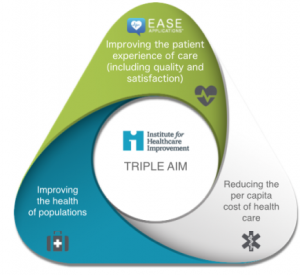The Triple Aim
With hospitals moving toward a value-based payment system there is more demand now than ever for strategies that will help healthcare systems hone in on population health. The Triple Aim, an initiative set forth by the Institute for Healthcare Improvement, covers three main checkpoints for all hospitals as they make this transition.
The Triple Aim
With hospitals moving toward a value-based payment system there is more demand now than ever for strategies that will help healthcare systems hone in on population health. The Triple Aim, an initiative set forth by the Institute for Healthcare Improvement, covers three main checkpoints for all hospitals as they make this transition.
Better Health
Better Care
Lower Cost
Whereas before healthcare systems may have focused solely on how they could achieve these aims in their hospitals and practices, now, they are being encouraged to go outside the scope of the hospital walls – and improve health in the community.

The Triple Aim | Cost
The US health care system is the most expensive in the world when you look at our healthcare expenses stacked up against our annual GDP. By 2020, healthcare spending is projected to reach 20% of our GDP.
The Triple Aim | Step-by-Step
How can hospitals reach the Triple Aim? The short answer is: as simultaneously as possible. Ideally, the three facets of the Triple Aim should be pursued—and achieved – at the same time, with the same gusto. The success of achieving the Triple Aim relies on a few steps:
- Identifying target (or at-risk) populations
- Find out and define what your system’s aims and measures will be
- Develop a project that will show your progress and evidence to support system-wide change
- Scale up testing for populations – look at the community you serve first, those are your potential patients: by understanding their socioeconomic and health state at a population level, you’ll better predict their needs.
The Triple Aim | Changes are Coming
Quite a bit of the US healthcare landscape has already shifted in a positive direction in terms of helping hospitals achieve Triple Aim outcomes: ACOs, bundled payments, changing our primary care models to incorporate shared decision making and patient-centered medical homes, and of course, the ongoing integration and development of new technology, inching us closer to the “one patient, one record” concept.
Hospitals nationwide are beginning to develop targeted, disease specific programs that will work with physicians to improve patient health and be a liaison between patients and physicians when it comes to care coordination and decision-making. The hope is that if healthcare systems can identify patients who are likely to have complicated—and costly—healthcare needs, they can better support them in education, motivation and treatment of their chronic conditions. In turn, better health will ensue. In addition to health improvement at the community level, care innovations will be a byproduct of working with patients, instead of the traditional model where the patient has little to no say in their treatment plan. And finally, lower costs. If patients are healthier, they won’t be utilizing services as much. Or, at the very least, if they have chronic conditions and several comorbidities that make it nearly impossible for them not to regularly utilize healthcare services, hospitals will have the means to treat them as economically as possible.
The Triple Aim is an exciting challenge that will ideally yield a healthier and more robust US healthcare system. If our population is healthier, the nation’s bank account will follow suit.